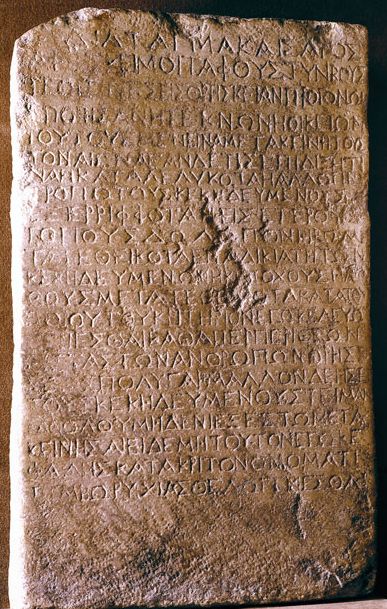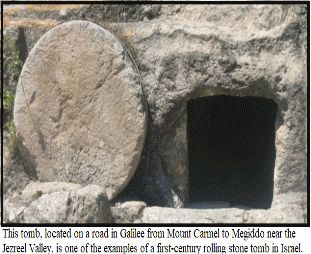
THE NAZARETH DECREE
& "the empty tomb"

The Nazareth Inscription or Nazareth decree is a marble tablet inscribed in Greek with an edict from an unnamed Caesar ordering capital punishment for anyone caught stealing a corpse. -- "Nazareth Inscription"; Wikipediai

There are two main legends for the empty tomb of Jesus. One of them dates back 2000 years. The other more recently in the recent 200 years.
HISTORICAL SOURCE. "Today nearly all historians, whether Christians or not, accept that Jesus existed and that the gospels contain plenty of valuable evidence which has to be weighed and assessed critically."ii Usually, when someone asks about whether there is a historical Jesus they have in mind corroborative evidence "outside" the New Testament. However, they forget that the New Testament itself is a compilation of historical material and books in and of itself. Someone did not just sit down one day and write a New York Times "BESTSELLER" Jesus of Nazareth can definitely be regarded as a historical figure by virtue of these witnesses.
DID JESUS JUST FAINT? There were Urban Legends even in the first century. But the following is a modern "hypothesis": "Jesus did not die." "He just fainted." "He was placed in the tomb still alive and the spices helped heal Him. He freed Himself even from the sealed tomb. [This would be as miraculous as the resurrection!] He as king would now lead the Jews to victory from Roman oppression through His followers; etc." Of course, at first hand, this is completely contrary to the teachings of Jesus and subsequently of His disciples. Jesus' kingdom was not of this world, as He told Pilate. Can moral teaching produce immorality? Historically, the execution by crucifixion explodes this.
CAN A MAN SURVIVE CRUCIFIXION? Crucifixion was a long horrible and agonizing but terminal act. Before being nailed to the cross Jesus had been tormented with bloody thorns, scourgings that had cut His body up profusely. He was so exhausted that He could not carry His cross all the way to Golgotha. The body was nailed to the cross and would not be removed until death was confirmed. "It is easy to tell if someone is still alive during a crucifixion, because they have to push up to breath. Crucifixion is essentially a death by suffocation. If the guard sees that the victim is limp for a long time, one can be sure they are dead."iii To be certain the executioners would break their legs. Jesus was declared dead by His Roman executioners and was so reported to Pilate. Only then would Pilate permit the public removal of Jesus' body for burial.
"Accordingly, interpretations based on the assumption that Jesus did not die on the cross appear to be at odds with modern medical knowledge" iv Also, this recent "200-year-old hypothesis is still the subject of debate to this day in popular circles but the scholarly literature considers it uncontroversial that Jesus died during the process of crucifixion."v
THE APOSTLE JOHN'S ACCOUNT. History records that Jesus existed and was definitely killed by the Romans.vi The apostle Johnvii wrote a record that is part of that history. He witnessed himself a soldier's lance pierce Jesus' side and saw blood and water that came forth. This history attests to His death. He was either dead by what is called "hypovolemic shock" or "by asphyxiation", either of which can result in fluid gathering around the heart.viii The water and blood attests that Jesus was dead. John confirms this.
THE FIRST CENTURY LEGEND. Or, Jesus died but His body was stolen from the tomb so that His disciples could keep His religious movement alive by His followers pretending He was resurrected.
PROJECTION BY THE RULERS. Those that had put Jesus to death remembered someone saying that Jesus claimed He would raise his body up the third day. They apparently had a better memory than the disciples in this matter. At any rate the wicked do "project" how they would think and do if they were their opponents. Since they would have no qualms about deceiving, they figured that the disciples might steal the body. They could inaugurate a movement that Jesus had raised Himself "so the last error shall be worse than the first" (Matthew 27:64).
THE HISTORICAL SEQUENCE. So on Saturday (the Sabbath) the Jewish chief priests and Pharisees came to Pilate the Roman authority and requested that he command that the tomb be made sure until the third day "lest His disciples come by night, and steal Him away and say to the public, 'He is risen from the dead'" (Matthew 27:62-64). Pilate authorized some Roman guardsix and the securing of the tomb. The guards were posted and the stone to the door of the tomb was sealed (verses 65-66).
Then Matthew reports a "great earthquake" when an angel came and rolled back the stone from the tomb and sat upon it.x The guards on watch were scared to death. Instead of reporting to the governor to whom they served some of the guard went to the chief priests who assembled with the Sanhedrin Court and related what had happened. The Court bribed the guards with silver coins and a promise of immunity from punishment from the governor if the guards circulated a fabricated story of a theft of Jesus' body (Matthew 28:2-4; 11-15).
THE FAKE NEWS. "When one now considers how detailed and thorough the Romans attended to the specific task of guarding themselves, and how severe the consequences were we must conclude that it is highly implausible that trained Roman guards could [all] have fallen asleep at Jesus’ tomb." On the one hand, the guards hoped that the Jewish authority might protect them from Roman punishment (death). On the other, the Sanhedrin were happy to oblige in exchange for the rumor that the disciples had stolen the bodies. xi
SO THE LEGEND OF GRAVE ROBBING BEGAN.
Suetonius adds that this was done “at the instigation of one Chrestos.”
ARCHAEOLOGY.
A marble slabxii preserved in Koine Greek of an imperial decree by Caesar was acquired in Nazareth during the latter part of the 19th century and made known in 1930. It orders capital punishment for anyone caught disturbing graves or tombs. "It is my will that graves and tombs lie undisturbed forever ... I require that he be executed for tomb robbery." It is scientifically dated on the basis of epigraphy to the first half of the 1st century AD." Finally, it is arguably dated to the beginning of the reign of Claudius because of Rome's change at that time in its political oversight of Galilee (AD 41-54).
The edict identifies three points of similarities with the fake news of the tomb guards: 1) the stealing of a corpse from a tomb, 2) a stone sealed tomb*, and 3) the new extreme reaction to the crime --the death penalty. *The type of tomb specifically referred to in the edict is the same type of tomb that Jesus was buried in. The edict is striking because corpse robbing would not have been normally a problem to Rome. Romans did not bury their bodies. The Romans burned them. This decree would then have been exclusively for societies such as the Jews. "Even into the 1st century A.D., the practice of cremation was the norm and burial and embalming was referred to as a foreign custom".xiii xiv
This unusual decree has been considered as the empire's reaction to the alarming spread of Jesus' disciples throughout the empire that were attributed with the agitations at that time in the Roman Jewish community. Acts 18:2 tells about Claudius' expelling "the Jews" from Rome in which Aquila and Priscilla were victims. In his history of Claudius Suetonius mentions a "Chresto" involved in the agitations. The blame being spread by the anti-Christian Jews to the Christian Jews would have been taken seriously by Claudius. The decree therefore is thought to have been based upon the false Jewish narrative circulated that disciples had stolen Jesus' body from the tomb and were making claims that caused disturbances. Nazareth was a good place to publicize the decree.
The theft of the body of Jesus is ludicrous on its very surface:
What personal motive would the apostles, have of stealing the body? The death of Jesus was the end of their hopes for the coming Kingdom of God. "...They were startled and frightened, thinking they saw a ghost" (Luke 24:37). Even Peter when faced with the resurrected Lord was still ready to go back his former occupation of fishing. The resurrected Lord transformed all from dejected and dispirited escapists into witnesses whom no opposition could muzzle. Even in the face of death. It is unlikely that any conspirators of deceat would ultimately die for something they knew to be false.
CONCLUSION. History confirms that Jesus lived, died, was buried and arose from the grave. History also confirms that men have and will project their evils upon other persons in the hope they will cover up and hide their evil deeds.
Gaylon West
THROW OUT THE LIFELINE
www.BibleStudyLessons.net
i en.wikipedia.org/wiki/Nazareth_Inscription
ii Stanton, Graham (2002). The Gospels and Jesus (Oxford Bible Series) (2nd ed.). Oxford University Press. p. 145. [https://en.wikipedia.org/wiki/Historicity_of_Jesus#cite_note- Stanton-1 ]. B. Ehrman, 2011 Forged: writing in the name of God ISBN 978-0-06-207863- 6. p. 285.
iii https://www.quora.com/Did-Jesus-faint-on-the-cross
iv Journal of the American Medical Association, March 21, 1986, 1463.
Ibid.
v Bergeron, Joseph W. "The crucifixion of Jesus: review of hypothesized mechanisms of death and implications of shock and trauma-induced coagulopathy." Journal of forensic and legal medicine 19.3 (2012): 113-116. quoted, https://en.wikipedia.org/wiki/Swoon_hypothesis
vi OTHER HISTORIANS. We might add that Jesus' manner of death is attested to. The Roman historian Tacitus in his"Annals" mentions the time of his death as being during Pontius Pilate’s governorship of Judea, during the reign of Tiberius. Tacitus therefore is a witness of the veracity of the witnesses. The contemporaneous works of the Jewish aristocratic priest - historian Flavius Josephus who had the patronage of three Roman emperors mentions Jesus as a real person twice in his Jewish Antiquities. Again, Josephus is not a witness for Jesus but for the eye-witnesses. Celsus, the Platonist philosopher, considered Jesus to be a magician who made exorbitant claims. Celsus is not a EYE-witness of Jesus but is a recorder of what was being circulated about Jesus; hence, his current world thought of Jesus. Magicians (or "fake" healers) were prominent during the first century; e.g., Simon of Samaria (Acts 8). Pliny the Younger, a Roman governor and friend of Tacitus, also wrote about the early Christian worship of Christ “as to a god.” Pliny is a witness to what the believers were doing from the eyes of their neighbors.
vii 19:35
viii https://www.compellingtruth.org/blood-water-Jesus.html
ix Robertson's Word Pictures. "Have a guard (echete koustōdian), present imperative, a guard of Roman soldiers, not mere temple police. The Latin term koustodia occurs in an Oxyrhynchus papyrus of A.D. 22. “The curt permission to the Jews whom he despised is suitable in the mouth of the Roman official” (McNeile)."
x According to John's record, Mary saw the stone removed but not the angel; she did not see Jesus until after reporting to Peter and John.
xi http://sntjohnny.com/front/guards-at-the-tomb-the-discipline-of-the-roman-soldier/2201.html
xii A French collector acquired the stone from Nazareth in the latter part of the 19th Century. It is now in the collections of the Louvre. .https://www.biblicaltraining.org/library/nazareth- decree;
xiii https://www.thoughtco.com/roman-burial-practices-117935
xiv Tacitus (historian) notes that necromancy with dead bodies was a practice in Germanicus north of Rome but William Lane Craig points out that such practice was "irrelevant to Christ" and Galilee. "Dale Allison on the Resurrection of Jesus - Reasonable Faith". Archived from the original on 23 February 2017. Retrieved 6 March 2017. Quoted at https://en.wikipedia.org/wiki/Stolen_body_hypothesis#cite_note-dale-allison-on-the- resurrection-of-jesus-11

|